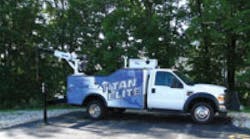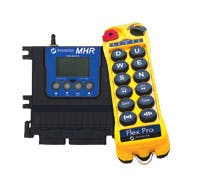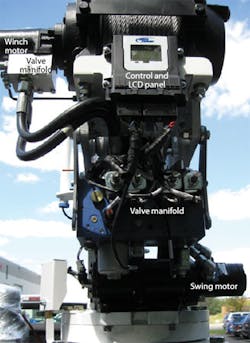Auto Crane Co., Tulsa, Okla., developed the very first auto crane in 1958 by placing a crane in the trunk of a car. This work-truck industry pioneer has since produced some of the most reliable cranes and crane-service bodies in the industry and now offers models with lifting capabilities to 14,000 lb.
Auto Crane, a subsidiary of Ramsey Industries, recently introduced a totally proportional crane control system in conjunction with Magnetek, Inc. and GS North America LLC. GSNA is a provider of electrohydraulic and electronic controls to original equipment manufacturers, and Magnetek is North America’s largest supplier of digital drive systems for industrial cranes, hoists, and monorails and wireless controls for overhead material handling and mobile hydraulic equipment.
The challenge for Magnetek and GSNA was to replace Auto Crane’s existing wireless hydraulic control and outdated hydraulic system. The old control system required an operator to use two hands to depress a proportional trigger and had an on-off thumb trigger providing single-function control. This configuration was cumbersome and inefficient and offered limited proportional functions. The radio remote control did not provide any crane status information, and was not scalable to meet individual user demands.
The old system
The old mobile hydraulic control system was similar to that in use by the majority of the industry and included a pistol grip transmitter, series hydraulic system, single pressure switch, and series circuits. The pistol grip transmitter had thumb-actuated toggle switches that activated only when the proportional trigger was pressed. In the event that the toggle was accidently released, the hydraulic system could slam to a halt without ramping down. The severe shock to the boom and truck often damaged the boom.
The system’s series plumbing caused flow degradation when two or more functions were engaged at the same time. Poor metering of the hydraulic oil caused the flow rate to drop by half when an additional function was put into operation. Series configuration is considered an outdated technique for hydraulic control and is a common problem with many of the systems currently in the field.
The series circuits also caused backpressure spikes if a lift cylinder bottomed out or if boom rotation hit a stop. This hydraulic shock was detrimental to the hoist motor and the system and could reduce hoist torque, resulting in an inability to lift.
Using a single pressure switch to monitor load was another issue that needed to be addressed. At some angles an overload alarm would be triggered even though the boom was loaded well under its capacity. At other points the crane was put into an over-capacity-use safety factor, which was not optimal for crane loading, but the alarm was not triggered. This situation is true of many cranes that still use a single pressure switch. In addition, machine stability wasn’t monitored because there was no angle sensor, nor was monitoring of the actual level of the truck itself provided.
All of these issues were rectified by the new system designed and manufactured by GSNA and Magnetek for Auto Crane’s numerous mobile hydraulic truck sizes and configurations.
The new system
GSNA and Magnetek provided the totally new crane control and operating systems that offer fully proportional hydraulic valve control, including multiple speed scaling and the ability to operate multiple functions of the crane simultaneously. The new system is comprised of three major components: the hydraulic system, the hand-held transmitter, and the receiver.
Level, pressure and proximity sensors measure positions, determine loading, and monitor speeds of critical machine functions. I/O modules provide electrohydraulic proportional control of the crane functions. The wireless controller is integrated with the vehicle’s CAN, including operator control.
GSNA provided custom hydraulics that include the industry’s first J1939 boom angle sensor with truck frame level monitoring. The hydraulic system valve bank from GSNA allows individual crane functions to operate in parallel, so each function can operate independently and without flow degradation inherent to series systems. This means the operator can extend or rotate the boom and lift at the same time. The valve bank provides 100% proportional control for all crane functions, eliminating uncontrolled swings and boom jerk. The multi-speed control scheme is an industry first and allows for multi-function creep control on the transmitter and speed scaling functionality on the control.
Each function is individually infinitely variable and allows setting ramp rates of the boom, telescoping cylinder, rotation, and hoist independently and controlling mass acceleration of the system. Maximum speeds of each function also can be independently set.
The new hydraulic system allows scaling speed and performance through the entire load range of cranes rated from 5000 to 14,000 lb. One valve bank is used through Auto Crane’s entire product range with the only change being the electric current parameters set through the control. Every crane has its own control profile, which is pre-loaded into the controller. The controller’s ability to read and match the correct control profile for each crane is where the marriage of the hydraulics and electronics excel.
Control system innovations
The wireless transmitter chosen for the system was Magnetek’s Enrange Flex Pro fully proportional hand-held transmitter. With it, an operator can ramp up or ramp down while lifting a load or rotating the boom. Each button is fully proportional and programmable — an industry first for truck-cranes.
The operator can adjust operation of the crane with full power at four different speed scaling levels: 100%, 75%, 50%, and 25%, and settings can be changed on the fly. The CE-certified Flex Pro operates at 433 MHz and includes an on-board emergency SIL-3 stop button as a safety interface. It is 70% lighter than the old transmitter, which allows for belt clip mounting and one-hand operation.
Magnetek also provided the receiver, its Enrange MHR wireless controller. It combines the components of a radio receiver and hydraulic controller into a single unit that significantly reduces costs and frees up valuable space on the trucks. It manages the output to the hydraulic valve bank as the transmitter is actuated. This ensures repeatable and constant performance at all temperatures and loads. The result is smooth ramp up and ramp down of each crane function independent of any other functions.
An LCD screen allows viewing system settings and a series of readouts that monitor the overall operation of the system — another first in the truck crane industry. Initial concern that the screen might not withstand the harsh, outdoor environments of the field were squelched after repeated shock and impact testing proved the LCD’s durability. The LCD allows diagnosing problems accurately and quickly because it shows more than just alpha-numeric status codes — actual descriptions are clearly spelled out.
The diagnostic system monitors all aspects of the machine functions, including boom angle relative to ground position, hydraulic pressure, winch status, and proportional outputs status. This closed-loop system also senses one of the biggest failures in the electrical system: cable failure. Indicating the status of the cable and the coil on the hydraulic solenoid can help an operator diagnose the source of a crane malfunction in 5 sec or less. The diagnostic system also provides preventive maintenance indication, error event logging and messaging.
Load management
A crane load management system incorporates boom-pressure transducers and dual-angle sensors for feedback of truck and boom angle status. The old system didn’t actually indicate the angle of the boom because it was dependent on whether or not the truck was level. The new system monitors the level of the truck in conjunction with a boom angle sensor. The system reconciles the two angles to the angle of the truck to provide the true boom angle, which can identify safety zones. The operator is notified when in a safe operating zone, and it becomes inoperable if the crane isn’t in a safe zone.
When the crane is operating at zero to 90% capacity, a light glows green. At 90% of rated capacity, the light turns yellow and the speed drops to 50%. The light turns red and a stop function is initiated if full rated capacity is exceeded. The new system allows for manual override, which was difficult with the old system.
Grueling tests
The system design underwent extensive field testing, including thermal cycle testing. GSNA decided to test to the JDQ53.3 electrical and environmental specifications because they are more comprehensive than SAE’s. During the thermal test, the controller was at 100% current load, the hydraulic system was at full power loading, and the controller was at 100% current. Every function was at 100% output for the entire thermal cycle test.
GSNA used a chamber to simulate numerous weather conditions, including rain and ice. The system was also tested outdoors in the depth of Wisconsin’s winter.
Rockwell Automation, as a third party tester, ran the IP rating testing on the MHR controller. The MHR passed all tests including a submersion test at 1 meter for 30 minutes. The system was fully functionally and there was no ingression of liquid.
Utilizing the latest in CAN technology, the total machine control solution provides improved safety and increased productivity, resulting in a mobile hydraulic crane design with numerous industry-first innovations that met the customer’s expectations.
This information was provided by Mark Torbett, advanced application manager at GS North America and Ben Stolle, manager of radio controls at Magnetek. For more information, call GSNA at (800) 261-8735 or visit www.gsna.com, or call Magnetek at (800) 288-8178 or visit www.magnetekmobilehydraulic.com.




